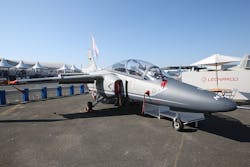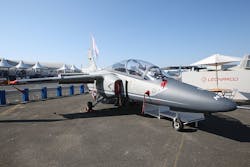Leonardo unveils M-345 multi-role trainer aircraft, wins Italian Air Force order
PARIS AIR SHOW. Leonardo is unveiling its M-345 training jet aircraft, which has piqued the interest of many Air Forces with costs comparable to those of a turboprop aircraft but that delivers superior performance, officials say. The first prototype carried out the first flight on the 29 December 2016; the first flight of the first pre-series aircraft is to happen by 2018. The Italian Air Force has already ordered five aircraft, with the first delivery expected by 2019.
The new aircraft enables Air Forces to contain the training times and provide students with a high-performing platform as compared with today’s turboprop trainers in service all over the world, officials say. The new M-345 exposes them to the most demanding missions of their training syllabus to obtain a high-quality training at lower costs.
The M-345 has a cockpit representative of the fighter’s excellent external visibility. Thanks to its wide flight envelope with high maneuver capability at high speed and both low and high altitude, its modern avionic systems, and high load capacity, the M-345 can carry out operational roles.
The aircraft’s long fatigue life, the maintenance philosophy organized only on two levels that eliminates the expensive general overhaul, and the Health Usage and Monitoring System (HUMS) are key elements helping reduce the operating and life-cycle costs of the M-345.
With the aircraft’s sophisticated embedded training simulation system, the pilot will see his training mission enhanced by a series of events which will have been arranged in the planning phase including other airplanes interacting with the mission itself and connected via data link with flying assets, ground simulator and other simulation devices. The system also envisages the presence of a Mission Planning and Debriefing Station (MPDS), with which it is possible to prepare mission scenarios, upload and download data, and review the missions carried out in the debriefing phase.
The engine is a turbofan Williams FJ44-4M-34 for military and aerobatic use. The cockpit is equipped with HOTAS (Hands On Throttle-And-Stick) commands, digital displays with three-color touchscreen MFD (Multi-function Display) and a Head-Up Display, that in the rear seat is replaced by a display repeater of images of the front HUD.

